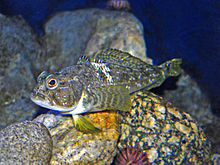
Summary
The emerald rockcod (Trematomus bernacchii), also known as the emerald notothen is a species of marine ray-finned fish belonging to the family Nototheniidae, the notothens or cod icefishes. It is native to the Southern Ocean where it is a commercially important species.[1]
| Emerald rockcod | |
|---|---|

| |
| Scientific classification | |
| Domain: | Eukaryota |
| Kingdom: | Animalia |
| Phylum: | Chordata |
| Class: | Actinopterygii |
| Order: | Perciformes |
| Family: | Nototheniidae |
| Genus: | Trematomus |
| Species: | T. bernacchii
|
| Binomial name | |
| Trematomus bernacchii Boulenger, 1902
| |
| Synonyms | |
| |

Taxonomy edit
The Emerald rockcod was first formally described in 1902 by the Belgian-born British ichthyologist George Albert Boulenger with the type localities given as Cape Adare in Antarctica at a depth of 5-8 fathoms and Duke of York Island at a depth of 3-4 fathoms.[2] In 1982 the Russian ichthyologist Arkady Vladimirovich Balushkin placed this species, and all the other species in its genus bar the type species, T. newnesi, in the new genus Pseudotrematomus but this has not been widely accepted.[3] The specific name honours the Australian Australian physicist and astronomer Louis Bernacchi who carried out much of the exploring and collecting of specimens during the Southern Cross Expedition, on which the type was collected.[4]
Description edit
This species is mostly brown in color with darker spots. The first dorsal fin contains 4-6 spines, the second dorsal fin has 34-39 soft rays and the anal fin has 31-35 soft rays. Females of this species can reach a length of 35 cm (14 in), while males only reach 28 cm (11 in). The maximum reported age for this species is 10 years.[1]
Distribution, habitat, and habits edit
This species is native to the Southern Ocean[1] on the seafloor at depths from very shallow waters to 700 m (2,300 ft). It is adapted to living in waters of extremely low temperature (-1.86 °C mean temperature in McMurdo Sound). It consumes various invertebrates and small fishes and also is known to feed on some algae.[1] Their foraging techniques make them the primary predators of the medium-sized population of the Antarctic scallop, Adamussium colbecki.[5]
Physiological adaptations for cold edit
Unlike most organisms, the emerald rockcod does not show a typical heat shock response; for example, it does not upregulate the heat shock protein gene hsp70 when in warm temperatures.[6] Instead, upregulation of hsp70 is more prominent when it is in its normal temperature environment.[6] Although normally hsp70 is an inducible gene, this gene was found to be expressed at all times in emerald rockcod. A constitutive heat shock gene hsc71 showed the same pattern of expression, and so it was deduced that in the emerald rockcod hsp70 was also being expressed as a constitutive gene.[7] Low temperatures in its Antarctic habitat may cause cellular stress that can denature the cellular proteins of these fish, making it necessary to express high constitutive levels of heat shock proteins.
References edit
- ^ a b c d Froese, Rainer; Pauly, Daniel (eds.) (2014). "Trematomus bernacchii" in FishBase. February 2014 version.
- ^ Eschmeyer, William N.; Fricke, Ron & van der Laan, Richard (eds.). "Species in the genus Trematomus". Catalog of Fishes. California Academy of Sciences. Retrieved 3 October 2021.
- ^ H.H. Dewitt; P.C. Heemstra; and O. Gon (1990). "Nototheniidae Notothens". In O. Gon and P.C. Heemstra (eds.). Fishes of the Southern Ocean. South African Institute for Aquatic Biodiversity. ISBN 9780868102115.
- ^ Christopher Scharpf & Kenneth J. Lazara, eds. (12 April 2021). "Order Perciformes: Suborder Notothenoididei: Families Bovichtidae, Pseaudaphritidae, Elegopinidae, Nototheniidae, Harpagiferidae, Artedidraconidae, Bathydraconidae, Channichthyidae and Percophidae". The ETYFish Project Fish Name Etymology Database. Christopher Scharpf and Kenneth J. Lazara. Retrieved 3 October 2021.
- ^ Ombretta Dell’Acqua; Thomas Brey; Marino Vacchi & Mariachiara Chiantore (2017). "Predation Impact of the Notothenioid Fish Trematomus bernacchii on the Size Structure of the Scallop Adamussium colbecki in Terra Nova Bay (Ross Sea, Antarctica)" (PDF). Polar Biology. 40 (8): 1557–1568. doi:10.1007/s00300-017-2077-4. S2CID 21243237.
- ^ a b Place, Sean P.; Hofmann, Gretchen E. (March 2005). "Constitutive expression of a stress-inducible heat shock protein gene, hsp70, in phylogenetically distant Antarctic fish". Polar Biology. 28 (4): 261–267. doi:10.1007/s00300-004-0697-y. ISSN 0722-4060. S2CID 18561415.
- ^ Place, Sean P.; Zippay, Mackenzie L.; Hofmann, Gretchen E. (August 2004). "Constitutive roles for inducible genes: evidence for the alteration in expression of the inducible hsp70 gene in Antarctic notothenioid fishes". American Journal of Physiology. Regulatory, Integrative and Comparative Physiology. 287 (2): R429–R436. doi:10.1152/ajpregu.00223.2004. ISSN 0363-6119. PMID 15117724.


